Picture this.
It’s 3:27 PM on a Tuesday, and you’re staring at your daily report like it personally insulted you.
You did three crowns, a new patient exam, two hygiene checks, and walked Mrs. Jenkins through her treatment plan like a dental therapist.
And yet… that net production? Trash.
PPO adjustments just stripped your revenue bare…..again.
You don’t need another “motivational” email telling you to hang in there.
You need a plan.
A real one.
One that doesn’t read like it was written by an insurance company in disguise.
Here’s the truth: going fee-for-service isn’t some cute Instagrammable #dentaljourney.
It’s real.
It’s hard.
It costs you comfort.
And yes, you’re probably going to lose some patients.
But if you stay in the hamster wheel of PPOs, you’re going to lose a whole lot more. Like your profit, your purpose, and your sanity.
This guide? It’s not a fluffy roadmap made for dentists with trust funds and time to burn.
This is the steak dinner version: juicy, honest, no-filter strategy with clear action steps to help you drop those PPOs one-by-one, keep your team aligned, and build the kind of practice that makes you excited to check the numbers again.
We’re not just talking about change. We’re making it.
And by the end of this PPO to fee-for-service transition timeline, you’ll know exactly what to do, month-by-month, decision-by-decision, to take your practice from PPO-dependent to proudly fee-for-service.
Hungry? Good. Let’s dig in.
Table of Contents
How Long Should a PPO-to-FFS Transition Take?
Let’s kill the fantasy right now: you’re not waking up next Monday, dropping every PPO contract you’ve ever signed, and skipping off into a sunset of cash-paying patients who say yes to full-mouth rehabs without blinking.
That’s not a transition. That’s a meltdown in scrubs.
The average dental practice in the U.S. writes off 30–50% of its production due to PPO adjustments. That’s not just a line item. It’s your time, your clinical skills, and your stress… evaporating.
But escaping that cycle takes more than a snap decision. It takes a timeline that works with your reality, not against it.
So how long does it take? Anywhere from 6 to 18 months. Yep, a full year (or more) isn’t uncommon, especially if you’re:
- Heavily tied into multiple insurance networks
- Dealing with a team that’s never known anything but PPO language
- Serving a patient base trained to think “insurance first, value second”
This timeline isn’t rigid.
It’s not linear.
And it sure as heck isn’t cookie-cutter.
Some practices move faster, especially if they’ve already started prepping their systems, team, and patients (and if that’s you, keep going). Others need more time to clean house, retrain staff, and overhaul their messaging from the inside out.
What matters is that you move intentionally, not impulsively.
You want to make the leap, but you also want to land on your feet, not flat on your collections report.
Why a Flexible Timeline Is Your Best Friend
Here’s what no one tells you about going fee-for-service: it’s just as much about mindset as it is about mechanics.
Yes, you need to know when to notify PPOs, retrain your front desk, and rewrite your treatment presentation scripts. But more than that, you need to give your team, and yourself, time to adapt.
Because every stage of this transition is going to stir up feelings:
- Doubt from your front desk staff when a longtime patient walks out
- Resistance from patients who feel “abandoned” by your insurance departure
- Fear from you, wondering if this move will tank your numbers
And none of that can be handled well when you’re rushing the process just to “get it over with.”
So instead of pushing a rigid 90-day sprint or a copy-paste “FFS in 6 Months” plan from a random Facebook group, we’re going to walk through a flexible, phase-based transition.
One that’s realistic, scalable, and actually respects the complexity of your practice.
You’ll be able to:
- Pause if patient loss spikes
- Accelerate when momentum picks up
- Adjust based on team readiness or cash flow shifts
And yes, you’ll do it with your eyes wide open. Because by the time we’re done, you won’t just know how long it’ll take.
You’ll know what to do at each step to make the time count.
Ready for the play-by-play?
Let’s get into the month-by-month breakdown.
Month 1–2: Assess, Audit, Align
This is the prep phase. No sledgehammers yet. No PPO cancellation letters.
Just you, your data, your team. And a brutally honest look in the mirror.
Think of this as your dental detox. Before you can break up with PPOs, you need to understand just how toxic the relationship has been.
1. Audit Your Write-Offs (The Financial Reality Check)
If you’ve never looked at your write-offs line by line, buckle up. This can feel like reading a credit card statement after vacation. You’ll be shocked at how much you’ve been giving away without realizing it.
Here’s what you need to analyze:
- Which PPOs are costing you the most?
- What percentage of your total production is written off per plan?
- How many patients are attached to each plan?
- Are your higher-value procedures even profitable under certain plans?
This is where most dentists go, “Wait, I’m actually paying them to do dentistry?!”
Recommended Tool:
- Jarvis Analytics – Pulls real-time data on profitability by payer and procedure. You can see which plans are gutting your margins and which are tolerable.
- Dental Intelligence – Gives you a dashboard to track production per patient, patient value trends, and treatment acceptance rates—all vital as you prep to drop insurance.
This is about being informed, not angry. You can’t build a smarter practice on blurry data.
2. Evaluate Case Acceptance + Revenue Per Patient
Let’s say you see 100 patients this month. How many of them said yes to treatment? How many actually followed through?
Fee-for-service success lives and dies by case acceptance and patient relationships. If your numbers here are weak, they’ll only get weaker once patients are footing the full bill.
Use this window to track:
- Your treatment plan acceptance rate
- Your average revenue per patient
- Your production by provider and procedure
This data tells you whether you’re building a practice that converts on value or just filling schedules with bodies.
3. Involve Your Team Early (No Surprises)
You might be the captain of this ship, but your team is the crew steering it through choppy waters. If they’re not on board, the whole thing sinks.
This month, hold a full team meeting and drop the news: “We’re moving toward fee-for-service.”
Here’s what that convo should include:
- Why you’re doing this (higher quality care, less burnout, more personalized service)
- How it’ll affect them (scheduling, payment conversations, performance incentives)
- What support they’ll get (training, scripts, regular check-ins)
Let them react. Let them process. But don’t let the vision get watered down.
Go deeper: Assign transition “champions.” These are team members who get excited about the shift and can help others adjust when things get tough.
4. Train Your Front Desk to Speak “FFS”
Insurance lingo is embedded in most front desks like muscle memory.
But now’s the time to start shifting language from “What’s your insurance?” to “We’d love to tell you how our practice works.”
This isn’t a full script flip yet, but get them practicing how to position value, not coverage.
Start role-playing:
- New patient phone calls
- In-office treatment discussions
- Questions about “Why don’t you take my insurance anymore?”
You’re planting seeds now that will bloom later.
FFS Transition Readiness Snapshot
Create a custom visual like this:
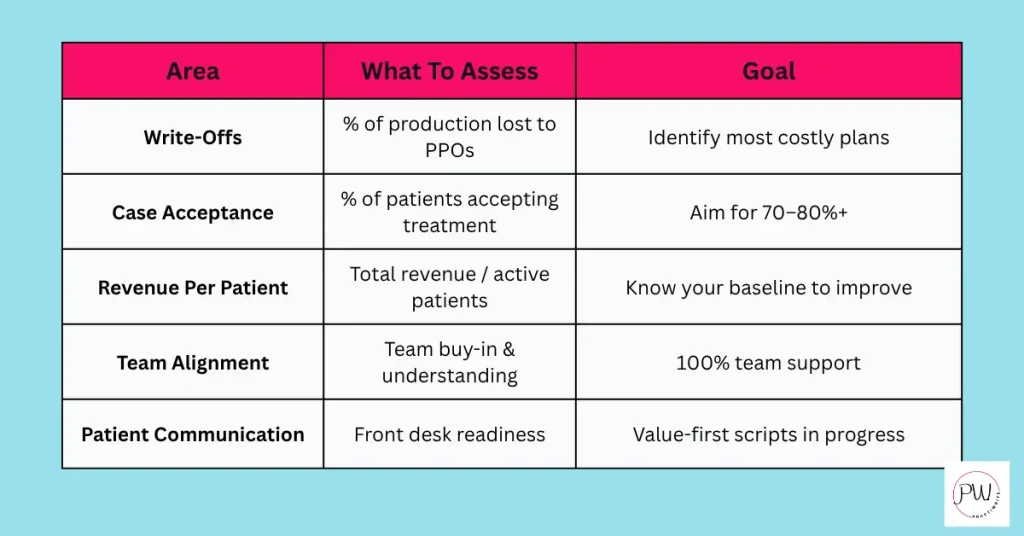
This phase is all about clarity. You don’t need to make big changes yet. But you do need to shine a light into every dusty corner of your practice.
When you see the numbers, hear your team’s feedback, and start speaking a new language, you’ll begin to feel the shift. Even before you cancel a single PPO.
Month 3–4: Communicate + Clean Up Ops
This is where most practices either build momentum….or backpedal fast.
Why? Because this is the first time the change becomes real.
You’re not just talking about leaving PPOs anymore.
You’re prepping patients, cleaning up systems, and building the backbone of your fee-for-service identity.
So, deep breath.
Because this phase is all about bold communication and quiet system overhauls.
Start Prepping Patient Communication (Transparency > Damage Control)
You don’t owe insurance companies anything.
But your patients? They deserve respect and transparency.
And no, “We’re dropping your plan, sorry!” taped to the front desk won’t cut it.
Start crafting your communication strategy now. So when you do drop your first PPO (soon!), your patients feel informed, not ambushed.
What you’ll need:
- A PPO withdrawal letter: Mail and email versions
- In-office talking points: Front desk & clinical team need to speak with one voice
- FAQ sheet: “What does this mean for my care?” / “Will I still get reimbursed?” / “Can I still come here?”
Tone matters. Your messaging should be:
- Confident, not apologetic
- Patient-focused, not insurance-bashing
- Hopeful, not defensive
Real-World Example Language:
“You’ve probably noticed changes in the way insurance companies operate—and how much they limit the time, quality, and care providers like us can offer. To serve our patients better, we’re moving toward a fee-for-service model that prioritizes personalized care over red tape.”
This isn’t just PR. It’s leadership.
Audit and Simplify Your Internal Systems
You know those 17-step workarounds your team uses to submit claims, track codes, and manually reconcile PPO adjustments?
Yeah. Time to Marie Kondo that shiz.
Start simplifying now so your back-end isn’t dragging you back when you go full FFS.
System cleanup checklist:
- Billing software review: Are you over-relying on PPO code bundles?
- Eligibility checks: Can your team stop checking benefits for every patient, every time?
- Payment options: Do you have cash, credit, and third-party financing in place?
- Reporting systems: Can you easily track production-per-patient, collection rate, and case acceptance?
Recommended Tool:
- Weave – Centralizes calls, texts, payments, and reviews. A game-changer for FFS practices who want frictionless patient communication.
- YAPI – Helps automate patient reminders, digital forms, and online check-ins—cutting down on admin time and making your front office leaner.
Use this time to unclog your workflows. The simpler your systems, the smoother your transition will be when patients start questioning everything.
Refresh Your Website Language + Online Messaging
If your homepage still screams, “We Accept Most Major Insurance Plans!” you’ve got work to do.
You don’t need a full rebrand right now. But you do need to align your digital presence with your FFS values.
Start shifting your message from “insurance convenience” to “exceptional, personalized care.”
Update your:
- Homepage headline and intro paragraph
- Services page to emphasize quality, not coverage
- Contact page with a new patient welcome blurb
Quick SEO Tip:
Incorporate keywords like “out-of-network dentist,” “fee-for-service dental care,” and “dental care without insurance” to start ranking for the patients you’re now targeting.
Link back to your Local SEO and Google Maps Pack blogs here to show them how to attract ideal patients post-PPO.
Get Your Reviews Strategy in Motion
Your online reviews are your street cred—and when you stop taking insurance, that credibility becomes even more crucial.
Use this time to:
- Ask happy patients for reviews (especially those already paying out-of-pocket!)
- Highlight reviews that speak to your patient care, not just your pricing
- Make review collection part of your front desk’s daily workflow
Recommended Tool:
- BirdEye – Helps automate Google review requests after visits, streamlines feedback, and boosts your local SEO.
This helps build social proof. So when someone hears “they don’t take my insurance,” their next thought is, but everyone says they’re worth it.
Patient Communication Prep Checklist
A branded checklist image like this would make a great visual in the blog or as part of your lead magnet:
Patient Communication Prep: Month 3–4
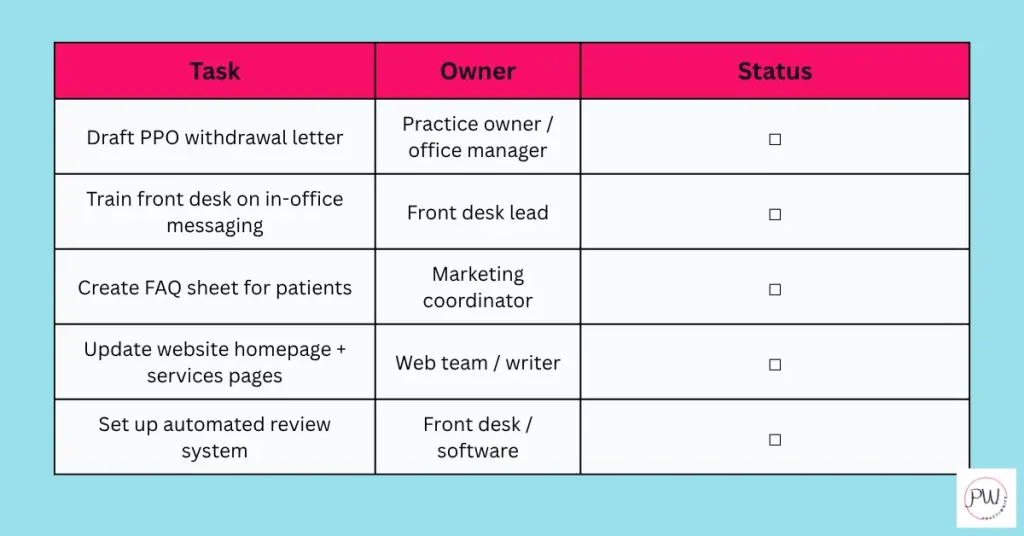
By the end of Month 4, your practice should look and sound different, even if you haven’t dropped a single PPO yet.
That’s the point. You’re conditioning your team and your patients for the shift ahead.
Next up? We make it real. Dropping the first PPO and seeing what happens when the rubber meets the road.
Month 5–6: Let Go of the First PPO
Okay. You’ve done the audits.
Your team’s aligned.
Patients are being prepped.
Now it’s time to do the thing most dentists only talk about: dropping that first PPO.
This is the turning point. The moment your practice officially steps off the hamster wheel.
And yeah, it’s going to feel risky.
But let’s be clear: staying trapped in plans that gut your margins is a bigger risk than leaving them.
Choose Your First PPO Strategically
You don’t have to go nuclear on every PPO at once. Start with the one that hurts the most.
The best PPO to drop first is one that:
- Has the lowest reimbursement rates
- Brings in the fewest patients
- Has a high admin cost (hours spent verifying, chasing claims, resubmitting nonsense)
Use Your Data
From earlier (Month 1–2), you should have identified:
- Your average write-off per plan
- Number of active patients under each plan
- Overall revenue tied to that plan
This decision should be cold, calculated, and backed by numbers, not emotion.
Submit Termination Notice
Every PPO has its own process for leaving (because of course they do). Some require 30 days’ notice, others up to 90 days.
Some will play games to delay your exit.
Here’s what to do:
- Submit your termination letter in writing (email + certified mail)
- Request written confirmation of receipt
- Mark your exit date on the calendar and don’t miss it
This isn’t a breakup where you “stay friends.” Once it’s done, it’s done.
Roll Out Patient Communication Plan
Now’s the time to send that PPO withdrawal letter and start calling patients under that plan.
Key messaging points:
- Emphasize that you’ll still see them, you just won’t be in-network.
- Explain that they can still use their benefits, but you’ll help them file claims as an out-of-network provider.
- Reinforce the value of the care they receive with you vs. insurance limitations.
Sample Talking Point:
“Nothing about our care is changing. We’re still your dental home. We’re just stepping away from a system that’s been limiting how we serve you. We’ll help you file for reimbursement, and we’re still here for every exam, every treatment, every question.”
You’re not asking them to make a decision today. You’re giving them notice, clarity, and confidence.
Track Patient Reactions (and Your Emotions)
I’m not going to sugarcoat anything here. Some patients will leave.
This is normal.
Plan for a 10–20% drop-off from the PPO patient pool you’re exiting. But don’t panic.
Instead, track:
- How many patients stay vs. leave
- How many use OON (out-of-network) reimbursement
- What objections your team is hearing most
Use this info to:
- Refine your scripts
- Update your FAQ sheet
- Boost confidence in your team for the next PPO drop
Also, you need to monitor yourself. This phase can feel like a gut punch if you’re not emotionally prepped.
Losing longtime patients? That stings.
But those weren’t your patients. They belonged to the insurance plan.
Now, you’re building a patient base that stays because of who you are, not what you accept.
That’s the practice that will become and remain profitable for years to come.
Have a Post-Drop Team Debrief
Once the first PPO is officially behind you, get the team together.
What worked?
What didn’t?
What pushback did they hear?
Create space to:
- Celebrate the win (yes, it’s a win, even if it was messy)
- Adjust your systems or messaging
- Plan your timeline for the next PPO exit (coming up soon!)
Example PPO Exit Tracker
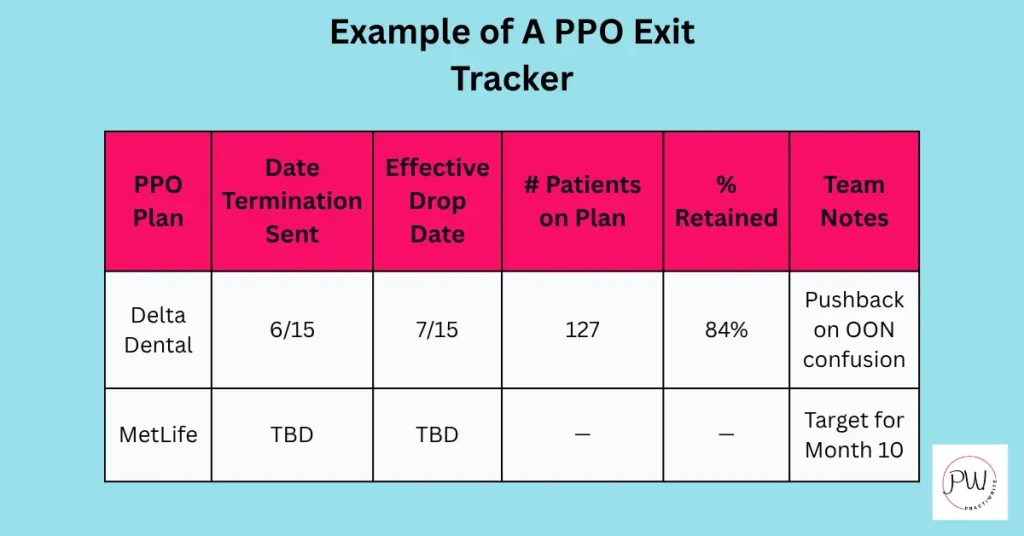
By the end of Month 6, your practice has done something huge: It made a clean, professional break with at least one PPO.
Your patients are adjusting.
Your team is gaining confidence.
And your systems are shifting to serve your real goals, not insurance paperwork.
It’s not perfect. It’s not painless.
But it’s progress. And that’s everything.
Month 7–9: Optimize, Market, Refine
You’ve dropped a PPO. Patients didn’t riot. The practice didn’t burn down.
Now it’s time to get strategic because this is where the real leverage lives.
These three months are about doubling down on what worked, fixing what didn’t, and starting to actively attract patients who fit your new FFS model.
Analyze the First Drop: What Did You Learn?
Now that the dust has settled, let’s look at what actually happened after you dropped that first PPO.
Here’s what to review:
- Retention Rate: What % of PPO patients stayed? (A solid benchmark is 70–85% retention depending on patient loyalty and communication.)
- OON Reimbursement Usage: How many patients are still using insurance out-of-network?
- Case Acceptance Trends: Did treatment acceptance increase among remaining patients?
- Revenue Impact: Has production-per-patient gone up?
Pro Tip: Use your software to visualize this.
- Dental Intelligence can help you track production, case acceptance, and trends over time.
- Jarvis Analytics breaks this down by provider, location, procedure, and payer.
These aren’t just numbers. They’re signals.
If retention was higher than expected? You’re ready to drop another PPO sooner than planned.
If case acceptance dipped? It’s time for more front desk coaching.
Turn Up the Marketing: Show Off Your New Identity
Let’s be blunt: if your marketing still looks like you’re insurance-first, patients are going to assume you’re just another PPO mill.
Now’s the time to reposition.
Here’s what you need to optimize:
- Website Headlines: Swap out “We Accept Most Insurance Plans” for messaging like: “Experience dental care that puts your health—not your insurance—first.”
- Google Business Profile: Update your services, post about your FFS model, and ask happy patients to leave reviews that mention value and experience.
- Email Campaigns: Create a series that educates patients on:
- Why you left PPOs
- What FFS care really means
- How they can still use their benefits
- Why you left PPOs
Recommended Tool:
- Mailchimp or ActiveCampaign – Use for automated FFS patient education sequences.
- Reputation – Manage and respond to reviews across platforms. Builds trust fast.
You’re not just managing optics. You’re changing perception.
This is how you attract patients who want your care, not just coverage.
Lean into Referrals + Reviews
This is the quiet goldmine. Patients who stay with you post-PPO are your ideal FFS patient avatars. Use them.
Referral system ideas:
- Offer a non-monetary thank-you gift (gift cards, dental goodies) when a patient refers someone
- Create a “VIP Patient Circle” email list for your best referrers
- Hand them a few custom referral cards before they leave the office
Review strategy:
- Ask every retained PPO patient to leave a Google review sharing why they stayed
- Highlight phrases like “worth it even without insurance,” “out-of-network but amazing,” or “transparent and trustworthy care”
These testimonials become proof points for every new patient on the fence.
Optimize Team Systems + Case Presentation
At this stage, you’re no longer reacting. You’re refining.
This means:
- Front desk scripts should now be confident, clear, and FFS-first
- Financial conversations should focus on value, not discounts
- Clinical presentations should elevate your care as the differentiator—not price
Keep training your team. Case presentation is a learnable skill and it’s one of the highest ROI levers in your business.
Recommended Tool:
- Trainual – Build an internal training library so every team member knows how to handle financial objections, insurance questions, and value-based presentations.
- BoomCloud – Launch or fine-tune your in-house membership plan to provide options for uninsured patients or those who leave their PPO plan.
Patients don’t just want great dentistry. They want confidence in the process.
Before-and-After FFS Shift Graphic
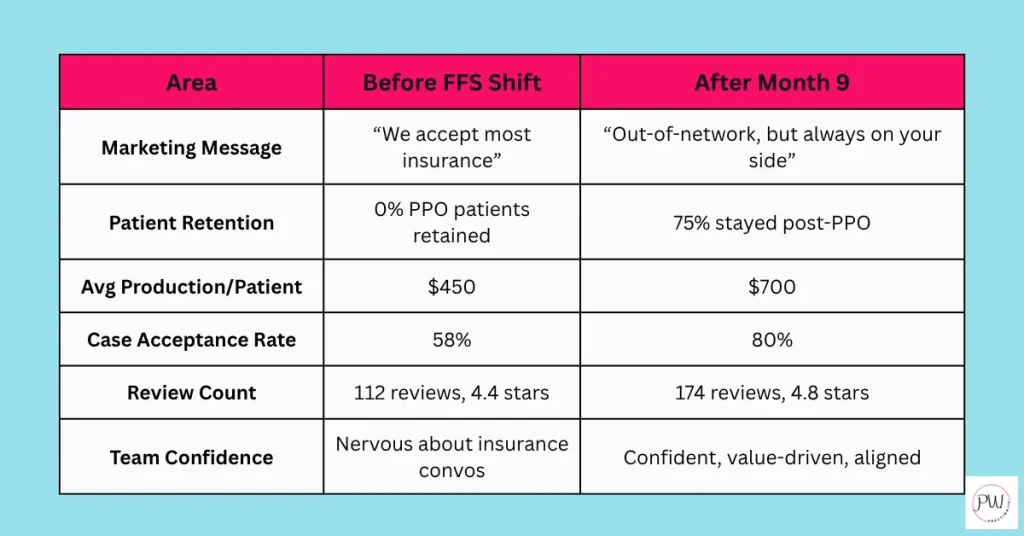
By the end of Month 9, your practice will have:
- Successfully dropped a PPO
- Retained the majority of patients
- Upgraded internal systems
- Repositioned your brand identity
- Laid the groundwork to scale this success
You’re no longer testing.
You’re becoming.
Month 10–12: Drop the Next PPO + Scale Your Systems
You’ve walked through the fire, and you’re still standing.
In fact, you’re doing better than ever.
This quarter is your opportunity to capitalize on everything you’ve built:
- Drop the next PPO (maybe even two, if you’re ready)
- Multiply your internal efficiencies
- Increase patient value per visit
- Strengthen your in-house payment systems
- Keep stacking proof that this FFS thing works
Let’s make this feel less like a risk and more like a rollout.
Review Your Metrics Again (You’re Smarter Now)
Before you make another move, go back to your dashboard and ask:
- Which PPO is next in line to go?: Look for the worst blend of low reimbursement and high admin hassle.
- Where are your patients coming from now?: Is your marketing starting to pull in OON or cash-pay patients?
- Are your case acceptance and collections trending upward?: If yes, you’re ready. If not, pause, fix, then move forward.
This isn’t about perfection. It’s about confidence grounded in data.
Drop Your Next PPO (Or Two)
This phase is often easier than the first drop because now you and your team have seen it work.
If your retention rate was strong from the last PPO, you may be ready to drop two plans this time. Just make sure they:
- Don’t represent the bulk of your active patient load
- Aren’t tied to long-term contractual obligations
- Won’t disrupt cash flow during a sensitive time (holidays, tax season, etc.)
If one of the PPOs you’re dropping covers a lot of hygiene patients, consider beefing up your hygiene reactivation and pre-appointment systems in parallel to offset attrition.
Send another clear, compassionate withdrawal letter and be consistent in your front desk messaging. You’re not apologizing, you’re leading.
Launch or Refine Your In-House Membership Plan
At this point, if you haven’t already launched one, now’s the time to implement a custom in-house plan.
This gives former PPO patients an easy way to stay, even if they feel weird about being fully fee-for-service.
Recommended Tool:
- BoomCloud – Builds and manages your membership program. You can offer preventive care, treatment discounts, and value-based perks without giving away your margin.
In-house plans:
- Create predictable revenue
- Foster loyalty
- Keep you in control
Bonus: they’re a killer selling point when patients say, “So what do you offer without my insurance?”
Refine Systems for Higher Case Acceptance & Production
By now, your team should be moving with confidence. Time to sharpen it even further.
Internal optimization checklist:
- Team scripting refresh – Revisit scripts for case presentation, financial conversations, and OON explanations.
- Daily production goals – Shift from “how full is our schedule?” to “how productive is our day?”
- Financing options – Offer CareCredit, Sunbit, or other plans to ease cost discussions without lowering fees.
- Clinical workflows – Identify time-wasters in ops. Streamline where you can. More time = better care = higher value perception.
Recommended Tool:
- Trainual – Create a digital training SOP that keeps your team sharp as you grow.
- Sunbit – Offers quick, patient-friendly financing. High acceptance rate—even for patients with average credit.
This is about increasing per-patient production without grinding your team into the floor.
Create a “Wins Wall” to Keep Team Morale High
Here’s the part most dentists skip, but it’s crucial:
Celebrate your progress. Visibly.
Post a giant whiteboard in your staff room or create a Slack channel for “FFS Wins Only.” Every week, track:
- Patients who stayed after a PPO drop
- Case acceptance victories
- Membership plan sign-ups
- Google reviews mentioning FFS care
Why? Because culture is currency.
When your team sees they’re winning, they’ll lean in harder.
Example PPO Exit Momentum Chart
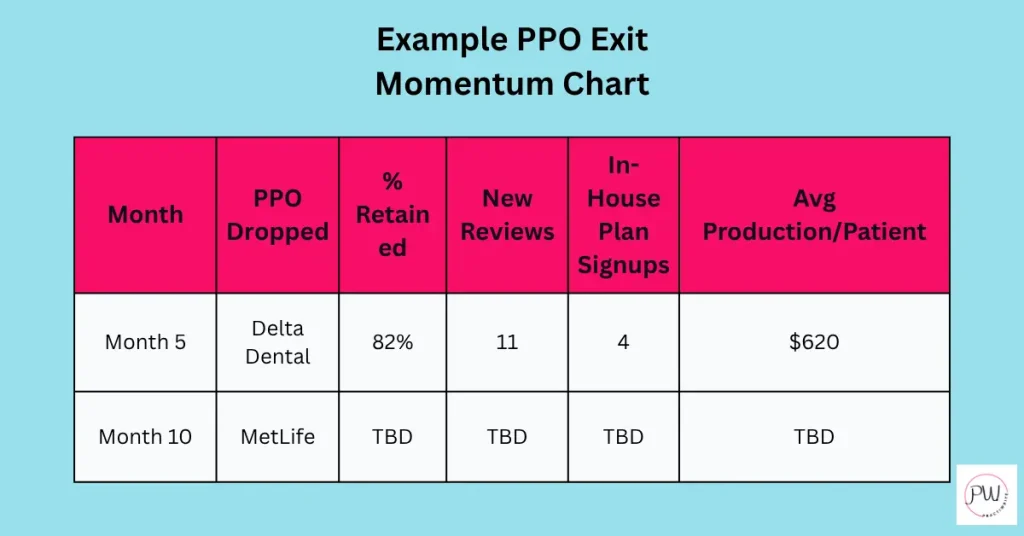
By the end of Month 12:
- You’ve dropped multiple PPOs
- You’ve retained more patients than you thought possible
- You’ve implemented an in-house plan
- Your production-per-patient has likely increased
- Your team is aligned, energized, and finally off the hamster wheel
You’re not experimenting anymore.
You’re running a real-deal FFS dental practice built on strategy, courage, and damn good care.
Next up? The long game.
Month 13+: Ongoing Optimization
Congratulations.
If you’ve made it this far, you’ve done something most dentists never will: You’ve stopped letting insurance companies call the shots in your business.
But here’s what no one tells you…
Fee-for-service isn’t a destination.
It’s a discipline.
It’s not “one and done.” It’s rinse, refine, repeat.
Because even without PPOs, you still have to earn every patient’s trust, optimize every system, and show up like a real business owner, not just a technician in a white coat.
This phase is about long-term thinking.
Stability.
Scalability.
And sustainable growth.
Make Ongoing Data Review a Non-Negotiable
You’re not flying blind anymore. So stop acting like you are.
Build a monthly dashboard that includes:
- Active patients (FFS vs OON)
- Average production per patient
- Case acceptance rates
- In-house plan performance
- Collections rate (aim for 98% or better)
Have a standing monthly meeting (even if it’s just you and your office manager) to review the numbers and make one key improvement each cycle.
This is how you prevent slow leaks and keep revenue strong—even when the schedule feels light.
Recommended Tool:
- Dental Intelligence – Still the GOAT for tracking the right KPIs and making data-driven decisions in a FFS model.
Reinforce Team Alignment With Quarterly Reviews
Burnout isn’t always about workload.
Sometimes it’s just confusion.
Keep your team invested in your mission with:
- Quarterly team meetings to review goals, share wins, and recalibrate scripts or systems
- Mini-retreats or training days to dig deep into patient experience, case presentation, or office culture
- Bonus structures tied to team-wide performance (not just production)
The clearer the path, the stronger your culture.
Build “FFS Mindset” into your onboarding for new hires. Your future team shouldn’t need reprogramming. They should be trained on excellence, not insurance.
Stay Loud With Your Marketing
You’re no longer the insurance-driven practice down the street. You’re the practice patients go to when they want to be treated like more than a policy number.
But that story needs to be told again and again.
- Keep publishing blog content and SEO-optimized pages (yes, I said it—keep blogging)
- Share behind-the-scenes wins on social
- Encourage patients to tell others why they stayed with you, even without in-network perks
- Build a referral program that rewards loyalty and brings in quality leads
NOTE: Check out my previous blogs on ranking in the Google Maps Pack, Google Business Profile optimization, and Local SEO to stay visible to new patients.
Monitor Patient Flow + Value Regularly
Not every month will feel like a rocket ship. But over time, your patient base should:
- Grow steadily
- Convert at a higher rate
- Spend more per visit
- Refer more like-minded patients
If you’re not seeing those things? It’s not a failure, it’s feedback.
Revisit your messaging, tighten your systems, and adjust without shame. You’re still in the driver’s seat.
Keep Scaling Without Losing Your Soul
This is the phase where some FFS practices think about expansion.
Another location.
Associate docs.
More tech.
Great! As long as you protect the philosophy that got you here.
Your next-level goals don’t need PPOs either.
Just make sure your growth doesn’t dilute your standards.
Stay focused on:
- Patient relationships > patient volume
- Profitability per hour > number of butts in chairs
- Care delivery > coverage negotiation
Example of a Forever FFS Practice Dashboard Template
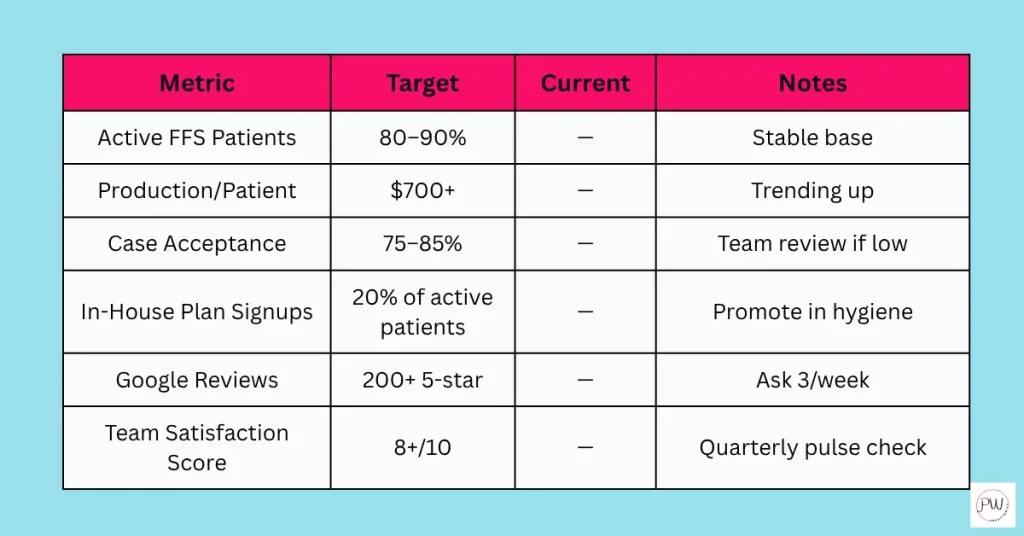
A Final Word: You Made It. Now Keep Going.
You’ve dropped PPOs.
Built systems.
Aligned your team.
Rebuilt patient trust.
Proved that you can practice on your terms.
This isn’t a fantasy. This is your new normal.
And if you’re still feeling the occasional “What if we fail?” thought creeping in. Congratulations, you’re human.
But the data doesn’t lie.
Fee-for-service works when you work it.
And you don’t have to figure out the rest of the journey alone.
Ready to Fast-Track Your FFS Success? Let’s Build Your Roadmap.
Want to see exactly where your practice stands now and how far you can go without PPOs?
Book your free strategy session with me and get your customized Dental Practice Roadmap:
✔ How your numbers stack up
✔ Where you’re losing money now
✔ Your next 3 moves for unstoppable FFS growth
Let’s put rocket fuel under your transition.
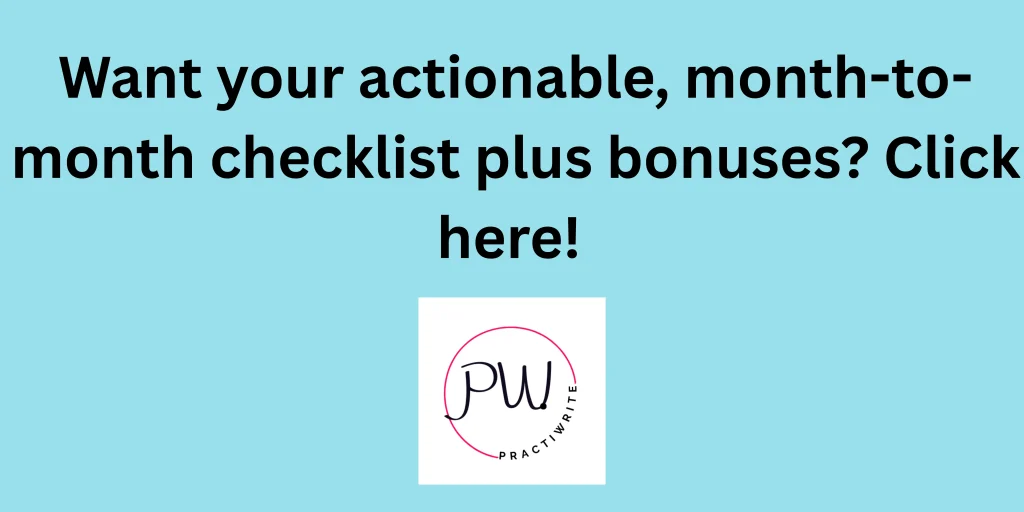
10+ year content strategist, writer, author, and SEO consultant. I work exclusively with dental practices that want to grow and dominate their local areas.
